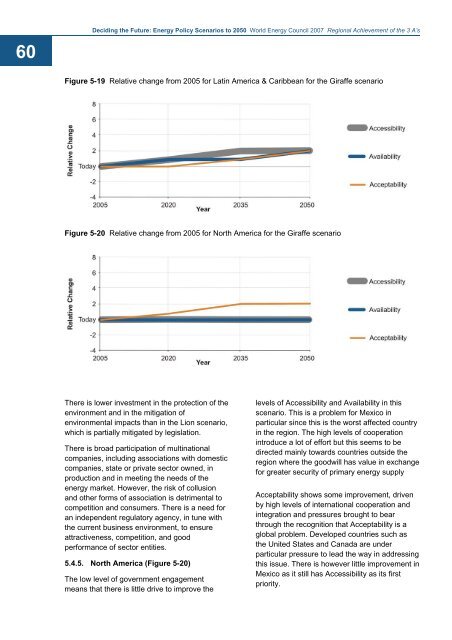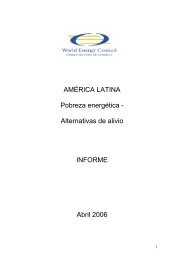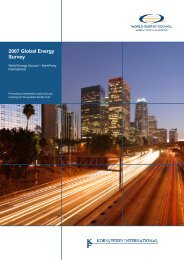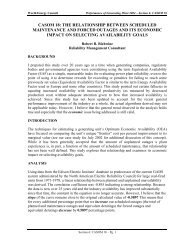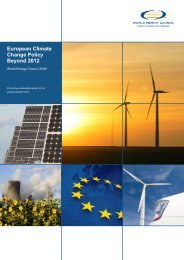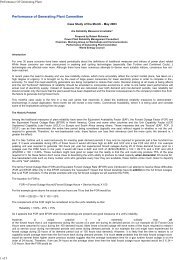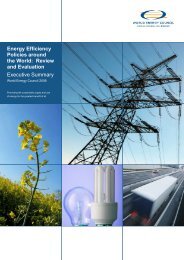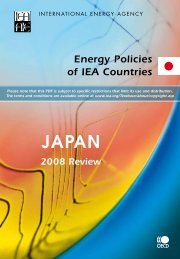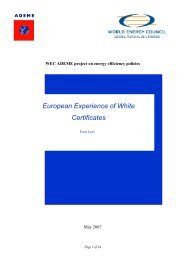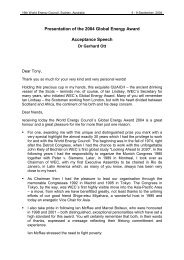Deciding the Future: Energy Policy Scenarios to 2050
Deciding the Future: Energy Policy Scenarios to 2050
Deciding the Future: Energy Policy Scenarios to 2050
Create successful ePaper yourself
Turn your PDF publications into a flip-book with our unique Google optimized e-Paper software.
60<br />
<strong>Deciding</strong> <strong>the</strong> <strong>Future</strong>: <strong>Energy</strong> <strong>Policy</strong> <strong>Scenarios</strong> <strong>to</strong> <strong>2050</strong> World <strong>Energy</strong> Council 2007 Regional Achievement of <strong>the</strong> 3 A’s<br />
Figure 5-19 Relative change from 2005 for Latin America & Caribbean for <strong>the</strong> Giraffe scenario<br />
Figure 5-20 Relative change from 2005 for North America for <strong>the</strong> Giraffe scenario<br />
There is lower investment in <strong>the</strong> protection of <strong>the</strong><br />
environment and in <strong>the</strong> mitigation of<br />
environmental impacts than in <strong>the</strong> Lion scenario,<br />
which is partially mitigated by legislation.<br />
There is broad participation of multinational<br />
companies, including associations with domestic<br />
companies, state or private sec<strong>to</strong>r owned, in<br />
production and in meeting <strong>the</strong> needs of <strong>the</strong><br />
energy market. However, <strong>the</strong> risk of collusion<br />
and o<strong>the</strong>r forms of association is detrimental <strong>to</strong><br />
competition and consumers. There is a need for<br />
an independent regula<strong>to</strong>ry agency, in tune with<br />
<strong>the</strong> current business environment, <strong>to</strong> ensure<br />
attractiveness, competition, and good<br />
performance of sec<strong>to</strong>r entities.<br />
5.4.5. North America (Figure 5-20)<br />
The low level of government engagement<br />
means that <strong>the</strong>re is little drive <strong>to</strong> improve <strong>the</strong><br />
levels of Accessibility and Availability in this<br />
scenario. This is a problem for Mexico in<br />
particular since this is <strong>the</strong> worst affected country<br />
in <strong>the</strong> region. The high levels of cooperation<br />
introduce a lot of effort but this seems <strong>to</strong> be<br />
directed mainly <strong>to</strong>wards countries outside <strong>the</strong><br />
region where <strong>the</strong> goodwill has value in exchange<br />
for greater security of primary energy supply<br />
Acceptability shows some improvement, driven<br />
by high levels of international cooperation and<br />
integration and pressures brought <strong>to</strong> bear<br />
through <strong>the</strong> recognition that Acceptability is a<br />
global problem. Developed countries such as<br />
<strong>the</strong> United States and Canada are under<br />
particular pressure <strong>to</strong> lead <strong>the</strong> way in addressing<br />
this issue. There is however little improvement in<br />
Mexico as it still has Accessibility as its first<br />
priority.


